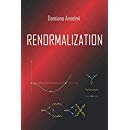Purely virtual particles
Several particles are not observed directly, but only through their decay products. We consider the possibility that they might be fakeons, i.e. fake particles, which mediate interactions but are not asymptotic states. A crucial role to determine the true nature of a particle is played by the imaginary parts of the one-loop radiative corrections, which are affected in nontrivial ways by the presence of fakeons in the loop. The knowledge we have today is sufficient to prove that most non directly observed particles are true physical particles. However, in the case of the Higgs boson the possibility that it might be a fakeon remains open. The issue can be resolved by means of precision measurements in existing and future accelerators.
Mod. Phys. Lett. A 34 (2019) 1950123 | DOI: 10.1142/S0217732319501232
Talk given at the conference
Max Planck Institute for Mathematics in the Sciences, Leipzig
October 04, 2018
I claim that the best correspondence principle for quantum field theory and quantum gravity is made of unitarity, locality and proper renormalizability (which is a refinement of strict renormalizability), combined with fundamental local symmetries and the requirement of having a finite number of fields. Quantum gravity is identified in an essentially unique way. It emerges from a new quantization prescription, which introduces the notion of fake particle, or “fakeon”, and uses it to resolve the long-standing problem of the higher-derivative ghosts. I discuss the major physical prediction of the theory, which is the violation of causality at small distances. The correspondence principle identifies the gauge interactions uniquely in form, but does not predict the gauge group. On the other hand, the matter sector remains almost completely unrestricted.
We discuss the fate of the correspondence principle beyond quantum mechanics, specifically in quantum field theory and quantum gravity, in connection with the intrinsic limitations of the human ability to observe the external world. We conclude that the best correspondence principle is made of unitarity, locality, proper renormalizability (a refinement of strict renormalizability), combined with fundamental local symmetries and the requirement of having a finite number of fields. Quantum gravity is identified in an essentially unique way. The gauge interactions are uniquely identified in form. Instead, the matter sector remains basically unrestricted. The major prediction is the violation of causality at small distances.
OSF preprints | DOI: 10.31219/osf.io/d2nj7
PhilSci 15287 (v1: PhilSci 15048)
Preprints 2018, 2018110213 | DOI: 10.20944/preprints201811.0213.v1
We elaborate on the idea of fake particle and study its physical consequences. When a theory contains fakeons, the true classical limit is determined by the quantization and a subsequent process of “classicization”. One of the major predictions due to the fake particles is the violation of microcausality, which survives the classical limit. This fact gives hope to detect the violation experimentally. A fakeon of spin 2, together with a scalar field, is able to make quantum gravity renormalizable while preserving unitarity. We claim that the theory of quantum gravity emerging from this construction is the right one. By means of the classicization, we work out the corrections to the field equations of general relativity. We show that the finalized equations have, in simple terms, the form $\langle F\rangle =ma$, where $\langle F\rangle $ is an average that includes a little bit of “future”.
Class. and Quantum Grav. 36 (2019) 065010 | DOI: 10.1088/1361-6382/ab04c8
We investigate the properties of fakeons in quantum gravity at one loop. The theory is described by a graviton multiplet, which contains the fluctuation $h_{\mu \nu }$ of the metric, a massive scalar $\phi $ and the spin-2 fakeon $\chi _{\mu \nu }$. The fields $\phi $ and $\chi _{\mu \nu }$ are introduced explicitly at the level of the Lagrangian by means of standard procedures. We consider two options, where $\phi $ is quantized as a physical particle or a fakeon, and compute the absorptive part of the self-energy of the graviton multiplet. The width of $\chi _{\mu \nu }$, which is negative, shows that the theory predicts the violation of causality at energies larger than the fakeon mass. We address this issue and compare the results with those of the Stelle theory, where $\chi _{\mu \nu }$ is a ghost instead of a fakeon.
J. High Energy Phys. 11 (2018) 21 | DOI: 10.1007/JHEP11(2018)021
A theory of quantum gravity has been recently proposed by means of a novel quantization prescription, which is able to turn the poles of the free propagators that are due to the higher derivatives into fakeons. The classical Lagrangian contains the cosmological term, the Hilbert term, $
\sqrt{-g}R_{\mu \nu }R^{\mu \nu }$ and $\sqrt{-g}R^{2}$. In this paper, we compute the one-loop renormalization of the theory and the absorptive part of the graviton self energy. The results illustrate the mechanism that makes renormalizability compatible with unitarity. The fakeons disentangle the real part of the self energy from the imaginary part. The former obeys a renormalizable power counting, while the latter obeys the nonrenormalizable power counting of the low energy expansion and is consistent with unitarity in the limit of vanishing cosmological constant. The value of the absorptive part is related to the central charge $c$ of the matter fields coupled to gravity.
J. High Energ. Phys. 05 (2018) 27 | DOI: 10.1007/JHEP05(2018)027
The “fakeon” is a fake degree of freedom, i.e. a degree of freedom that does not belong to the physical spectrum, but propagates inside the Feynman diagrams. Fakeons can be used to make higher-derivative theories unitary. Moreover, they help us clarify how the Lee-Wick models work. In this paper we study the fakeon models, that is to say the theories that contain fake and physical degrees of freedom. We formulate them by (nonanalytically) Wick rotating their Euclidean versions. We investigate the properties of arbitrary Feynman diagrams and, among other things, prove that the fakeon models are perturbatively unitary to all orders. If standard power counting constraints are fulfilled, the models are also renormalizable. The S matrix is regionwise analytic. The amplitudes can be continued from the Euclidean region to the other regions by means of an unambiguous, but nonanalytic, operation, called average continuation. We compute the average continuation of typical amplitudes in four, three and two dimensions and show that its predictions agree with those of the nonanalytic Wick rotation. By reconciling renormalizability and unitarity in higher-derivative theories, the fakeon models are good candidates to explain quantum gravity.
J. High Energy Phys. 02 (2018) 141 | DOI: 10.1007/JHEP02(2018)141

 Quantum Gravity
Quantum Gravity 


